When researchers compared the five-year quality-of-life outcomes and cost-effectiveness of three treatments for varicose veins—intravenous laser ablation, ultrasound-guided foam sclerotherapy, and surgery—they found that disease-specific quality of life was better after laser ablation or surgery, and Laser removal emerged as the most cost-effective option. This according to a large multicenter study published on September 5, 2019, in New England Journal of Medicine.
“… in all three groups, quality of life 5 years after treatment improved from baseline,” the authors write.
Researchers conducted a randomized controlled trial of 798 patients with varicose veins at 11 centers in the United Kingdom. They compared disease-specific and overall quality of life outcomes at five years, as well as the cost-effectiveness of the procedure.
Of the 595 patients who completed quality-of-life questionnaires, disease-specific quality of life favored laser ablation and surgery more than foam sclerotherapy. Overall quality of life measures were similar between the three treatment groups. And laser removal had the best chance of being cost-effective. The authors write that at a willingness-to-pay ratio threshold of $28,433 per quality-adjusted life-year, 77.2% of cost-effectiveness model iterations leaned toward laser ablation. A two-way comparison of foam sclerotherapy and surgery favored surgery in 54.5% of the model.
Two- and three-year follow-up studies after treatment of varicocele show that laser ablation, foam sclerotherapy, and surgery have equivalent recurrence rates and quality of life.
At five years, these researchers found that patients reported no recurrence of their varicose veins in 58 percent of the laser ablation group, 54 percent of the surgical group, and 47 percent of the foam therapy group.
“The differences in quality of life observed in our study are likely related to the fact that the presence and extent of varicose veins at 5 years was less in the laser ablation and surgery groups than in the foam sclerotherapy group, because the quality of disease life has previously been shown to be worse among patients who have recurrent disease than among those who do not,” the authors write.
On the other hand, 11% in the laser ablation group, 14% in the foam sclerotherapy group and 7% in the surgery group had further treatment, according to the paper.
Patient satisfaction was high in this trial, according to the authors, which could help explain the lower reintervention rates in this trial compared to other studies.
Foam sclerotherapy could be an evolving area among varicose vein treatments. Italian researchers reported in a paper published on October 22, 2019 in the journal Medical Device Expert Review that foam sclerotherapy is the most minimally invasive and cost-effective varicose vein treatment in the short term.
“Many different methods of foam preparation have been described in the literature,” they write. “In general, the method of foam production can affect characteristics such as stability and bubble size distribution, which in turn affect the therapeutic effect of the foam itself. Therefore, choosing an appropriate foaming technique is important for the success of the treatment. Future developments in foaming techniques are expected to make sclerotherapy, an already effective treatment, an even safer and more flexible treatment procedure.”
Disclosures:
The authors report no relevant disclosures.


